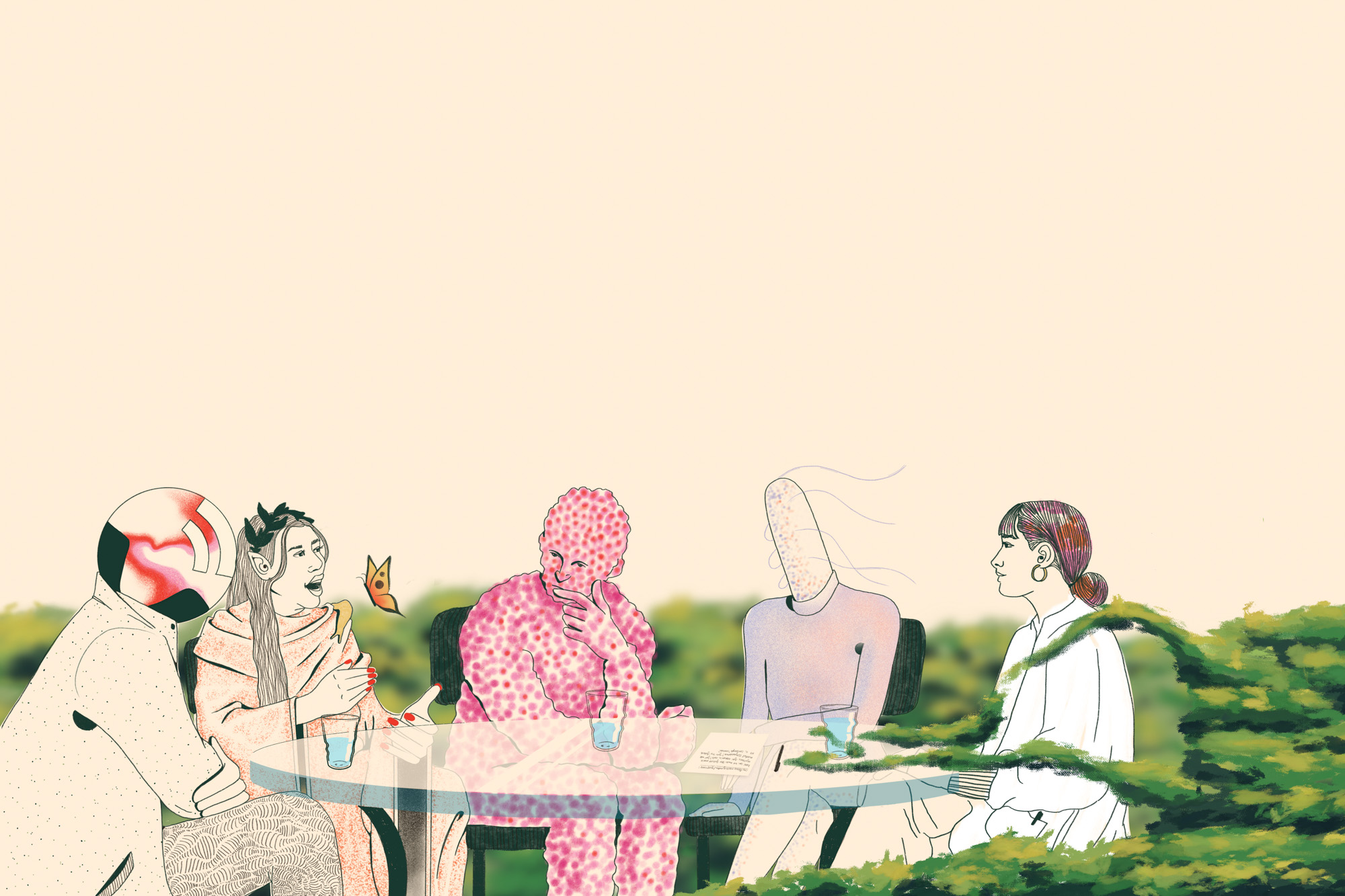The companies we work for have a great deal of sway over our lives. They determine our income bracket, our health care; they even influence our relation to the natural environment and what society we think is possible. Any debate over how to create a more equitable society must therefore consider how we build companies — and imagine radical new ways to configure them. To help us gauge what is possible in this space, we sat down with Nathan Schneider and Phoebe Tickell, two thinkers who research new forms of company governance. Nathan looks at history and the wide range of cooperative movements for inspiration; Phoebe looks to nature, and how novel ecosystems can inspire new ways of organizing. Together, we discussed the inequitable ways that corporate equity is currently distributed, and how to change that in the future.
Christina Agapakis: As we prepared for Ginkgo to go public earlier this year, we thought a lot about equity, and its seemingly contradictory meanings: On the one hand, this ideal of eliminating systemic barriers to creating a fairer society; on the other, ownership shares in a corporation. You both explore different ways of making company governance more compatible with the social side of equity. How do you think about this word? Are its two meanings reconcilable?
Phoebe Tickell: I think it’s a really interesting provocation, these two forms of equity. On the one side, you have this idea of the equal — the level playing field. You can think about it in terms of basic human needs, the things that every human should have access to. As a system-level thinker, the first question it raises is: Do people really need the same things to thrive? Is there something about this idea of equity that flattens our historical experience?
Thinking about equity in terms of ownership comes down to the question: What does it mean to own something? Ownership is basically this legal relationship with a thing, whether that’s a tangible or an intangible thing. At the bottom, it’s about being able to sue someone if they try to take it away. It’s about owning the value accrued by your assets. But what do you do when that ownership model applies to something like a forest, or any other natural resource that is a public good? Maybe that’s one place where the two equities overlap.
Nathan Schneider: Equity ownership of companies and other assets is a tremendous driver of wealth and power in modern societies, and yet almost all of it goes to a tiny minority at the very top. Most of the economic growth we’ve seen in the last few decades has gone to shareholders, not to the vast majority of wage-earners. That balance needs to change radically; we need to find ways to distribute equity more fairly.
But how do you do that? One legacy I’ve been exploring over the past few years is the cooperative business tradition, a global movement that has a kind of equality built into its understanding of equity, where all members of a co-op have equal vote even if some have more or less money in the system. That’s one way to do it — to disconnect influence from ownership.
These are high-stakes questions. There are signs that the scope of equity ownership may be expanding far beyond its role in the past. For instance, in blockchains and cryptocurrencies, you see the logic of company ownership being applied to everything. Fans become co-owners in their fandom, people become owners of stakes in virtual worlds, in artworks — everything broken up into little equities. We’re really at a crossroads, I think, in how we think about equity and ownership.
Christina: At Ginkgo, we spend a lot of time thinking about how we fit into this constellation — what kind of company we want to be. If you don’t look into it too deeply, there don’t seem to be that many options. Looking at companies around the world, it seems like there are these two stable states or patterns. On one side, you have giant, successful, profitable — but also often exploitative — corporations. On the other side, you have benevolent cooperatives that are things like these wonderful co-op bakeries — other small organizations like that. How do you break out of that binary?
Phoebe: It’s important to go beyond these binaries and explore the multifaceted possibilities in between. We need to tease apart ownership and management, as a company can be centralized in one way and decentralized in the other. For example, John Lewis [a UK-based partnership that owns department stores, supermarkets, and banks] is cooperatively owned by a trust on behalf of its shareholders, but in practice it’s hierarchically managed.
In the blockchain space, you can get companies with really decentralized horizontal leadership, horizontal teams, drawing explicitly on models from nature on how to organize in more holacratic, fluid forms. However, in some cases, there is still, in fact, just one person who has all the stake in the company. It’s a really interesting tension. You can have a totally horizontal and equity-based culture in a company where all the value is being siphoned off to a single shareholder. You see that in a lot of companies: a mismatch between the values and the culture and the actual legal and financial reality. That’s a discrepancy worth keeping an eye on.
Going back to your question about size and exploitation, there are examples of large corporate entities that organize in decentralized ways. There’s Haier Smart Home in China, a manufacturer for consumer electronics that has kind of become the poster child for the platform organization movement. They use an interesting networked model of self-managed microenterprises. Haier’s roughly 80,000 employees are organized in small self-contained teams. The company oversees a type of closed market of competition, where employees are encouraged to create their own independent startup units within the organization. Instead of a hierarchical chain of managers telling other managers what to do, everything evolves much more freely. It has a biological quality, this subsidiarity — pushing decisions to the local level. It allows for an efficiency and context dependence usually only seen in nature.
Nathan: We often have this sense that there’s a natural order to our economic life, an equilibrium — that things are the way they are for a reason. But any serious look at history reveals how these outcomes were brought about by particular decisions over time. The 30-year mortgage, for example, is dominant in the United States not because there is something really special about that time plan, but because that was determined in the 1930s when the policy relating to mortgages was established. Venture capital is not some kind of spontaneous invention. It was enabled in specific ways by the U.S. Congress.
The cooperative business structure and the joint stock company were developed around the same time in the mid- 19th century in their modern forms and have kind of co-evolved. One got much more support and attention than the other, partly because it promised to allow accumulation and centralization of wealth. The system that came out of that is portrayed as a natural spontaneous order, but it could have developed very differently. It’s always worth asking: What rules helped condition this outcome? That kind of systems approach is so important — understanding that our world is made of feedback loops that are not operating in a vacuum but are operating within certain set constraints.
Working with cooperative entrepreneurs over the years, I see them running up against walls all the time. Those walls are the legacy of social decisions that decided to empower investor- owned structures over cooperative organizations. When you run up against the limits of what a system enables, you start to see the way in which it is a system of rules, not this kind of arbitrarily open space that many businesspeople are trained to think of. When you see the rules and limits, you realize the system could have been designed differently, and it still can be.
Christina: Around the same time you’re talking about, when the joint stock company was developed, Darwin was writing about evolution. A lot of our ideas about how evolution works were shaped by the ways people in Victorian England thought society and the economy should work.
Phoebe: That’s totally right. And it was also vice versa. The way Darwin articulated his theory of evolution in terms of “competition” and “survival of the fittest” massively influenced how we now think about economies in Western societies, and the metaphors we use.
Christina: Exactly. This idea of natural selection enabled people to look at what was going on in society and think, “Obviously everyone is self-interested and selfish, and the absolute best rises to the top, right? I’m on top, and that’s the way it should always be because it’s natural!” It shows, mostly in a negative way, how science and capitalism formed each other. What kind of worlds might be possible if we recognize those biases and look to nature again through a different lens? What happens if we don’t twist biology to fit the status quo and instead try to find new metaphors, new modes to work with?
Nathan: I think we’re always going to be cribbing metaphors from biology. The best we can do is to not get too attached to any one metaphor and to continue bouncing them off each other. Fungi metaphors have become popular in recent decades. Suddenly everyone started trying to think what social movements can learn from mycelia, the new kinds of networks it could inspire. Of course, there are limits to that metaphor and the change it can bring, but it does offer a contrast to the tree-and-root metaphors that came before it.
I have a tendency toward a kind of democratic absolutism, but I try to remind myself that nature is an interplay of different systems. We have to allow those differences to play out in our own societies as well. We have to foster systemic complexity and multidimensionality; it’s part of our ambidextrousness as organizational creatures.
One example of this comes from open-source software. Some software projects, like the Debian operating system, operate very democratically, kind of like 18th century constitutional states. What I’ve had to realize is that they all occupy certain niches in the ecosystem. In the Linux computer that I’m using right now, running mostly open-source software, there’s a layer of a benevolent dictator at the kernel — it’s under the control of one person. And then there’s another layer that’s this constitutional democracy that’s really slow but has certain benefits. There are benefits to that being slow. And then there’s another layer that is a bit faster, a bit more market-focused. And each of those plays a distinct role. It’s a multi-use society.
The mixing of metaphors might not be an elegant rhetorical strategy, but in the context of organizational life it’s necessary. We need to have multiple ways of interacting with power, different ways of conceptualizing our relationship to nature.
Phoebe: Part of expanding the library of metaphors means appreciating that nature itself is not one way or another. People often say, “Nature is hierarchical. Look at groups of deer or lions.” But that’s our human projection onto how nature organizes. For a long time, for example, we thought that wolves organized in strictly hierarchical ways, around the leader of the pack. It turns out this was based solely on their behavior in captivity. They actually have complex power-sharing relationships in the wild, based on much more than the old strength-based dominance order.
As humans, we have an urge to make sense of nature through reductionist models — to categorize it in human language, which itself can be very reductive. Part of the problem is we take this very limited understanding of complexity — of nature, and the way things organize — and then we encode it into systems which are technological or economic or legal. We end up being governed by our encoded, reductionist understandings of the world.
What’s been interesting to me is applying what I learned as a biologist and a scientist to the space of governance. This has spanned decentralized and horizontal models of governance, to things like steward ownership, and how to govern with nature. It has gotten me to this point where I’m questioning the very notion of ownership. [Anarchist thinker] Pierre-Joseph Proudhon is known for his famous maxim, “Property is theft!” What’s less well known is the alternative he had in mind: embracing an economic mutualism, which is, in a sense, far more similar to the way that a forest operates than the way organizations operate — making us stewards rather than owners of the things we all benefit from. That may sound radical — but I doubt it’s radical in the face of where we need to go to actually stop the destruction of the planet.
I think it’s interesting, and exciting, to have this conversation with Ginkgo because you are a corporation and a company, so there are constraints to what you can do. At the same time, there are so many ways of experimenting and using the leeway available in those institutions. I wonder how much you can lean into these things.
Christina: That’s one reason Grow is doing this issue. As Ginkgo goes public now, we have the opportunity to think about how we can build governance around the ways our platform is built and used, and who will benefit from it. One thing we’re doing is giving all employees high voting shares, not just founders, with the goal of building a culture of ownership around the longterm value of what we are making. In this time of ecological and social crisis, how do you bring in more voices? How do you bring in nature, for example? How do you make nature a shareholder?
Nathan: I once worked with a cooperative that had a board seat reserved for Mother Nature.
Christina: How did they do it?
Nathan: That was the problem. It was so much to think about. I think they ended up just getting a representative of a nonprofit to stand in for nature. But the company didn’t really work in the end. It’s such an enormous idea that it can mean everything and nothing at once, but it’s a good exercise and a worthy ambition. The question is: What would it look like for us to really bring Mother Nature, Planet Earth, the ecosystem, into the basic accountability structure of our companies?
CEOs lie awake at night worrying about their shareholders. That’s baked into the structure. They don’t stay up worrying about the long-term safety of their workers or customers, who don’t have immediate power over them. And that’s why when we think about the kinds of feedback loops we want to have ultimately, that equity structure is really important to consider. I think there’s a clearly expanding recognition that the current model of shareholder maximization isn’t working. But that’s about as far as a lot of this has gone.
Christina: How do we move beyond that?
Nathan: By practicing on a small scale what we want to see on a large scale. This is how the cooperative movement emerged. It was a business movement that was also part of a political movement — the Chartist movement, which at the time was seeking to expand the vote for working class people in England. They had clear and ambitious demands. “Not only do we deserve the vote on a national scale, but look, we can run our own businesses democratically.” I think we’re in a moment where we are trying to figure out how to build those externalities on a large scale, while our world teeters on the verge of self-destruction. If we want to build them at large scales, we should probably also be working to build them at smaller scales.
Some strategies that people are exploring to do that involve things like updating the trust structure used by John Lewis to manage its employee ownership. There’s an organization called Purpose that is building trusts that reflect certain missions and introduce certain feedback loops into a company. That trust might own a certain share in the company. And if the company starts threatening to violate its purpose, that feedback loop kicks in. That could include something like an ecological feedback loop.
I wonder what we could do to encourage more of that experimentation around building internal constraints into companies so that they can adapt and they can optimize for the things that the society needs from them. Part of the problem we have right now is that there’s too little room for experimentation on what we are optimizing for. If we invite and encourage more experimentation for companies to take on social, environmental constraints, I think really interesting outcomes could emerge.
Phoebe: I think it is an exciting time for businesses that want to lead the way in determining what it really means to be an ecological organization in the future. Over the last year, I have been convening policymakers, researchers, academics, Indigenous leaders, and movement leaders to explore the question of how we bring the natural world into organizations and policy making. We’re working with organizations that are serious about going beyond “sustainability” to truly putting into practice protocols and accountability structures that incorporate the voice of Nature.
One of the places that we’ve been focusing our energies is creating new forms of value and measurement, because obviously part of the problem is that we’re not measuring, as you say, externalities. We are experiencing a crisis of measurement and a crisis of value. The fact that we value a tree as how many pieces of furniture or paper can come out of it is a crisis of both perception and measurement.
Capitalism is based on the wrong forms of measurement and value. How do we find a way for nature, and other ignored actors, to have their rightful value in our society? I feel like we’re just beginning to explore that.
Interview has been edited for length and clarity.



